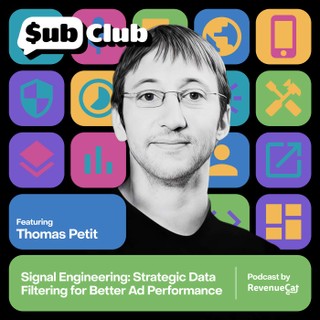On the podcast I talk with Thomas about using signal engineering to optimize ad spend, how AI is changing creative testing, and why most people should avoid app2web… for now.
Top Takeaways:
🧠 The biggest AI opportunity in ads is smarter analysis, not faster production
AI is now good enough to produce ad-quality video and variants at scale — but that’s where 95% of the industry focus stops. The underused frontier is AI for analysis: spotting winning hooks, predicting performance, and even pre-testing creatives with “AI humans” before spend. The teams that combine rapid AI production with AI-driven analysis can iterate faster and scale what works more reliably.
🔍 Signal engineering starts with fixing broken data
If the events you send to ad networks are inaccurate or poorly mapped, you’re sabotaging the algorithms. First step: make sure event counts match internal analytics within ~5–10% (not 30–50%). Then move from “normal” to “sophisticated” by filtering for quality — for example, optimizing to high-LTV trial signups instead of all trials — and sending value-adjusted revenue that reflects predicted LTV, not just day-one spend.
⚖️ Balance exploitation of winners with exploration of new concepts
When a creative crushes it, it’s tempting to flood your account with variations. But over-reliance on a single concept speeds fatigue and leaves you exposed when performance drops. Keep iterating on winners and testing new hooks in parallel — especially on fast-moving platforms like TikTok, where trends expire in weeks.
🌐 App-to-web works best for big brands with deep resources
Moving checkout to the web can bypass app store fees, but it’s a high-commitment experiment. Success usually requires brand trust, team bandwidth, and a well-tested flow — often with different plan structures than in-app. For most smaller teams, the opportunity cost outweighs the benefit. “Saying no to good ideas” is often the smarter prioritization.
💳 Hybrid monetization is powerful, but not plug-and-play
Combining subscriptions with one-time or usage-based purchases can capture more revenue from different segments — especially for AI-powered apps with real compute costs. But designing it to avoid cannibalizing subscriptions is complex. Treat hybrid as a later-stage lever: exhaust easier wins in pricing, packaging, and paywall optimization first, then experiment, possibly starting with Android or non-US markets.
About Thomas Petit:
👨💻 Independent app growth consultant helping subscription apps like Lingokids, Deezer, and Mojo.
📈 Thomas is passionate about helping subscription apps optimize their ad spend and increase ROI through smarter testing.
💡 “The whole idea of signal engineering and optimization of the data that you're sending back is: send the network something better, and they're gonna do a better job. They are doing a better job — it's you who are not doing yours.”
👋 LinkedIn
Follow us on X:
Episode Highlights:
[1:21] Testing smarter: How AI may be changing the game for testing ads.
[13:09] Untangling the web: App-to-web can work for some, but it’s not a slam dunk.
[21:19] Hedge your bets: The benefits of moving away from subscription-only and embracing hybrid monetization strategies.
[26:50] Going global: When and why to consider experimenting with hybrid monetization outside the US.
[31:15] Signal vs. noise: The signal engineering framework for sending the most valuable user interaction data to ad platforms.
[44:47] Multi-platform: Optimizing your data and event mapping for multiple ad networks.
[53:01] Low-hanging fruit: Scoring easy wins with signal engineering.
[1:08:04] Hands-off: Why ad networks likely won’t (and maybe shouldn’t?) implement built-in signal engineering tools for app marketers.
[1:14:05] Going deep: Advanced signal engineering techniques.
[1:26:09] Volume vs. quality: Why sending fewer events to ad networks may actually yield better results.



